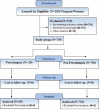Prognostic risk factors for early diagnosing of Preeclampsia in Nulliparas
- PMID: 24403715
- PMCID: PMC3883237
- DOI: 10.4103/0300-1652.122368
Prognostic risk factors for early diagnosing of Preeclampsia in Nulliparas
Abstract
Background: Preeclampsia is of major complications of pregnancy that is associated with maternal morbidity and mortality. Therefore, prediction and early diagnosis of preeclampsia would be helpful for better controlling of related complications. Our study aimed to investigate risk factors helping to predict and early diagnose of preeclampsia.
Materials and methods: A total of 739 nulliparous women at their 24-28(th) weeks of the first pregnancy were enrolled in this multi-center cohort study. Incidence or absence of preeclampsia in this population was evaluated up to the end of pregnancy period. For each case, a record sheet was assigned that contained information about haematocrit level in weeks 24-28(th) of pregnancy, blood pressure, result of roll-over test in weeks 24-28(th) of pregnancy and the presence of disease up to end of the study. Diagnosis of preeclampsia was made based on gold standard.
Results: Overall, 3.9 % of all cases developed preeclampsia. The mean maternal age, body mass index (BMI), years of education and positive roll-over test were significantly higher in preeclampsia group (P < 0.001). However, the mean gestational age and changes in the levels of haematocrit were significantly higher in normotensive cases (P < 0.001). Our combined model could predict preeclampsia with a sensitivity of 93% and a specificity of 80%.
Conclusion: Simple combined model of demographic characteristics including maternal age, BMI, years of education and positive roll-over tests can predict preeclampsia without any cost for the patients.
Keywords: Preeclampsia; pregnancy; risk factors; roll-over test.
Conflict of interest statement
Figures
Similar articles
-
Pregnancy outcomes in nulliparous women with positive first-trimester preterm preeclampsia screening test: the Great Obstetrical Syndromes cohort study.Am J Obstet Gynecol. 2021 Feb;224(2):204.e1-204.e7. doi: 10.1016/j.ajog.2020.08.008. Epub 2020 Aug 7. Am J Obstet Gynecol. 2021. PMID: 32777265
-
Clinical risk assessment in early pregnancy for preeclampsia in nulliparous women: A population based cohort study.PLoS One. 2019 Nov 27;14(11):e0225716. doi: 10.1371/journal.pone.0225716. eCollection 2019. PLoS One. 2019. PMID: 31774875 Free PMC article.
-
Early-onset preeclampsia appears to discourage subsequent pregnancy but the risks may be overestimated.Am J Obstet Gynecol. 2016 Dec;215(6):785.e1-785.e8. doi: 10.1016/j.ajog.2016.07.038. Epub 2016 Jul 25. Am J Obstet Gynecol. 2016. PMID: 27457117
-
Preeclampsia: an update.Acta Anaesthesiol Belg. 2014;65(4):137-49. Acta Anaesthesiol Belg. 2014. PMID: 25622379 Review.
-
Comparing levels of vitamin D, calcium and phosphorus in normotensive pregnant women and pregnant women with preeclampsia.J Obstet Gynaecol. 2020 Nov;40(8):1069-1073. doi: 10.1080/01443615.2019.1678575. Epub 2019 Dec 8. J Obstet Gynaecol. 2020. PMID: 31814492 Review.
Cited by
-
The Maternal Near Miss Incidence Ratio with WHO Approach in Iran: A Systematic Review and Meta-Analysis.Iran J Nurs Midwifery Res. 2019 May-Jun;24(3):159-166. doi: 10.4103/ijnmr.IJNMR_165_18. Iran J Nurs Midwifery Res. 2019. PMID: 31057630 Free PMC article. Review.
-
The effect of preoperative intravenous paracetamol administration on postoperative fever in pediatrics cardiac surgery.Niger Med J. 2014 Sep;55(5):379-83. doi: 10.4103/0300-1652.140376. Niger Med J. 2014. PMID: 25298601 Free PMC article.
-
Calcium-Vitamin D Co-supplementation Affects Metabolic Profiles, but not Pregnancy Outcomes, in Healthy Pregnant Women.Int J Prev Med. 2016 Mar 1;7:49. doi: 10.4103/2008-7802.177895. eCollection 2016. Int J Prev Med. 2016. PMID: 27076887 Free PMC article.
-
Prevalence and Risk Factors of Gestational Diabetes in Iran: A Systematic Review and Meta-Analysis.Iran J Public Health. 2015 Aug;44(8):1036-44. Iran J Public Health. 2015. PMID: 26587467 Free PMC article. Review.
References
-
- Schroeder BM. American College of Obstetricians and Gynecologists. Practice Guidelines ACOG Practice Bulletin on Diagnosing and Managing Preeclampsia and Eclampsia. Am Fam Physician. 2002;66:330–1. - PubMed
-
- Li Z, Zhang Y, Ying Ma J, Kapoun AM, Shao Q, Kerr I, et al. Recombinant vascular endothelial growth factor 121 attenuates hypertension and improves kidney damage in a rat model of preeclampsia. Hypertension. 2007;50:686–92. - PubMed
-
- Mehrabian F, Rezaei A. Early measurement of thrombus precursor protein (TPP) in the third trimester as a predictor of preeclampsia. Journal of Cell and Tissue Research. 2009;9:1855–8.
-
- Sibai B, Dekker G, Kupferminc M. Pre-eclampsia. Lancet. 2005;365:785–99. - PubMed
-
- Sibai BM. Maternal and uteroplacental hemodynamics for the classification and prediction of preeclampsia. Hypertension. 2008;52:805–6. - PubMed
LinkOut - more resources
Full Text Sources
Other Literature Sources



